Top 10 Foods Highest in Saturated Fat
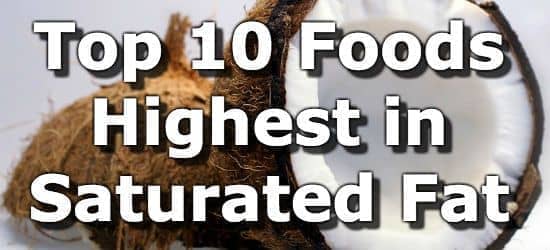
Saturated fats are solid fats, such as those found in meat, butter, lard, and coconut oil (as opposed to liquid oils, like olive oil, which contain unsaturated fats).
Recently the association between saturated fat and heart disease is in question. (1) Substituting "low-fat" refined carbohydrates for saturated fat is a bad choice. Instead, substitute saturated fats with healthier high-fat foods that actually lower cholesterol. (2,3)
Change in opinion on the effect of saturated fat and cardiovascular disease is not a reason to over-consume saturated fat. Even coconut oil should not exceed 10% of total calories. (4)
Foods high in saturated fat include whipped cream, dried coconut, fatty meats, processed meats, desserts, oils, cheese, milk, butter, and chocolate. The daily value (DV) for saturated fat is 20 grams per day. (5)
Below is a list of the top ten foods highest in saturated fat, for more see the lists of healthy high fat foods, unhealthy high fat foods to avoid, and high cholesterol foods.
List of Foods High in Saturated Fat
-
 1. Whipped Cream + Add
1. Whipped Cream + Add
Saturated Fat
per Cup WhippedSaturated Fat
per 100gSaturated Fat
per 200 Calories23.2g
(116% DV)19.3g
(97% DV)13.2g
(66% DV)See the list of all dairy foods high in saturated fat.
-
 2. Dried Coconut + Add
2. Dried Coconut + Add
Saturated Fat
per OzSaturated Fat
per 100gSaturated Fat
per 200 Calories16.2g
(81% DV)57.2g
(286% DV)17.3g
(87% DV)- 214% DV in 1 cup of coconut milk
- 146% DV in 1 cup of shredded coconut meat
Note: Coconut is a healthy high fiber food when consumed as part of a balanced diet. If you have high cholesterol, you may need to limit coconut consumption, but for most people, it is a great addition to your diet.
-
 3. Fatty Meats (Beef Short Ribs) + Add
3. Fatty Meats (Beef Short Ribs) + Add
Saturated Fat
per 3ozSaturated Fat
per 100gSaturated Fat
per 200 Calories15.1g
(76% DV)17.8g
(89% DV)7.6g
(38% DV)More Fatty Meats High in Saturated Fat
- 74% DV in a rack of pork ribs
- 52% DV in a 6oz skirt steak
- 46% DV in a pork chop with fat
See all meats high in saturated fats.
-
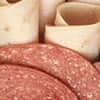 4. Processed Meats (Pepperoni) + Add
4. Processed Meats (Pepperoni) + Add
Saturated Fat
per 3ozSaturated Fat
per 100gSaturated Fat
per 200 Calories15.1g
(75% DV)17.7g
(89% DV)7g
(35% DV)More Processed Meats High in Saturated Fat
- 51% DV in 3oz of salami
- 42% DV in a bratwurst sausage
- 35% DV in 1 cup of cured ham
See all meats high in saturated fats.
-
 5. Desserts (Dulce De Leche) + Add
5. Desserts (Dulce De Leche) + Add
Saturated Fat
per CupSaturated Fat
per 100gSaturated Fat
per 200 Calories13.8g
(69% DV)4.5g
(23% DV)2.9g
(14% DV)More Desserts High in Saturated Fat
- 92% DV in 1/2 cup of chocolate mousse
- 55% DV in 1/2 cup of ice-cream
- 42% DV in a slice of cake with frosting
See all sweets and baked foods high in saturated fat.
-
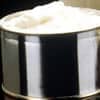 6. Palm Oil + Add
6. Palm Oil + Add
Saturated Fat
per TblspSaturated Fat
per 100gSaturated Fat
per 200 Calories11.1g
(55% DV)81.5g
(408% DV)18.9g
(95% DV)More Oils High in Saturated Fat
- 56% DV in 1 tblsp of coconut oil
- 41% DV in 1 tblsp of cocoa butter
- 32% DV in 1tblsp of beef tallow
See all fats and oils high in saturated fat.
-
 7. Whole Milk + Add
7. Whole Milk + Add
Saturated Fat
per CupSaturated Fat
per 100gSaturated Fat
per 200 Calories9.1g
(46% DV)1.9g
(9% DV)6.1g
(31% DV)More Dairy High in Saturated Fat
- 31% DV per 16oz glass of 2% fat milk
- 26% DV in 1 cup (8oz) of plain yogurt
- 1% DV in a 16oz glass of skim milk
See the list of all dairy foods high in saturated fat.
-
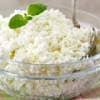 8. Cheese (Ricotta) + Add
8. Cheese (Ricotta) + Add
Saturated Fat
per 1/2 CupSaturated Fat
per 100gSaturated Fat
per 200 Calories8g
(40% DV)6.4g
(32% DV)8.6g
(43% DV)More Cheese High in Saturated Fat
- 35% DV in 1oz of hard goat cheese
- 29% DV in 1oz of colby
- 27% DV in 1oz of cheddar
See the list of all dairy foods high in saturated fat.
-
 9. Butter + Add
9. Butter + Add
Saturated Fat
per TblspSaturated Fat
per 100gSaturated Fat
per 200 Calories7.2g
(36% DV)50.5g
(252% DV)14.1g
(70% DV) -
 10. Dark Chocolate (85% Cocoa) + Add
10. Dark Chocolate (85% Cocoa) + Add
Saturated Fat
per 1oz SquareSaturated Fat
per 100gSaturated Fat
per 200 Calories7g
(35% DV)24.5g
(122% DV)8.2g
(41% DV)Note: Dark chocolate is a heart-healthy food, but should be eaten in moderation.
Printable One Page Sheet
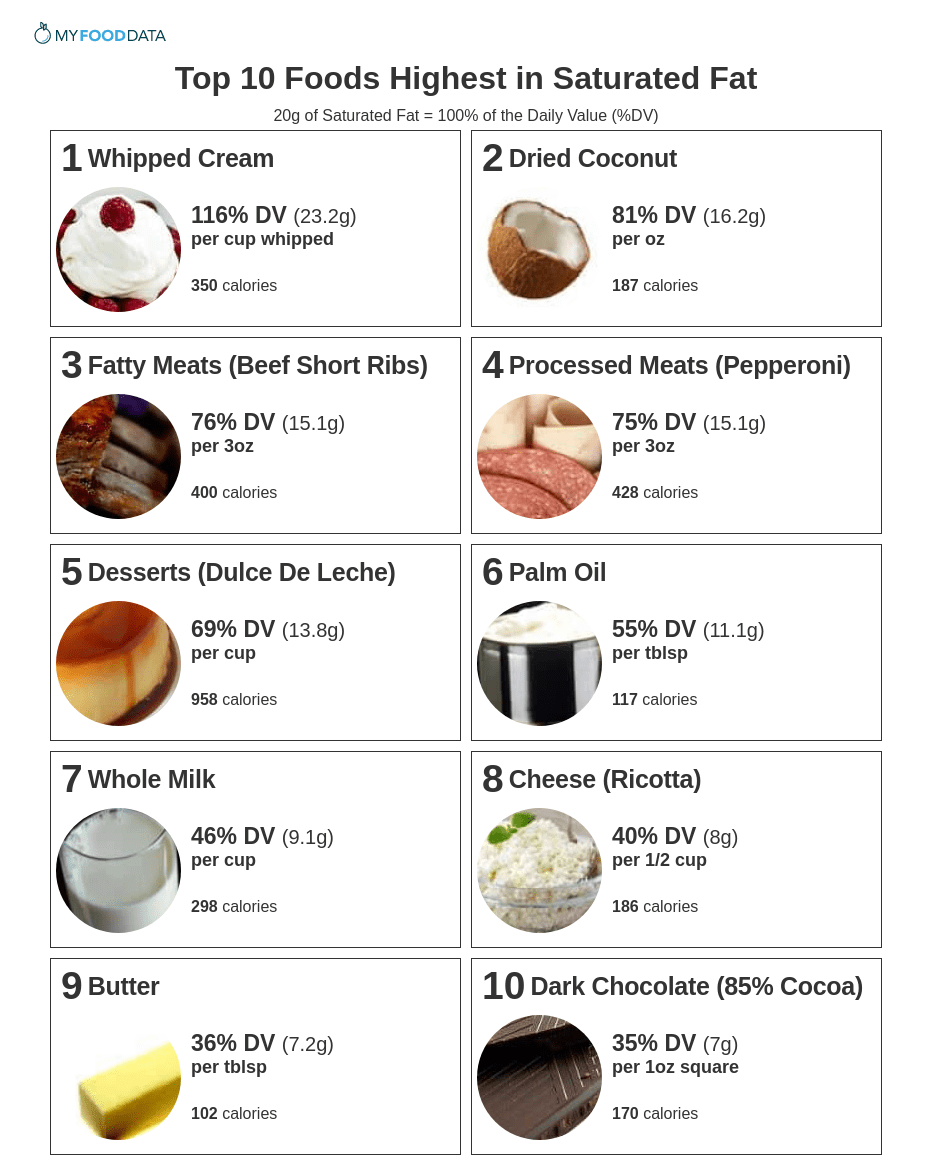
Does Saturated Fat Increase Blood Cholesterol?
The relationship between saturated fat and blood cholesterol is a source of much controversy. In recent times, new studies suggest that the relationship between saturated fat and blood cholesterol is not as strong as thought. (6,7)
The recommendation to replace saturated fat with refined carbohydrates also made the problem worse. Instead, saturated fats should be substituted with poly-unsaturated fatty acids (PUFAs) and whole grains which do reduce cholesterol. (8,9,10)
Further, not all saturated fats are created equal. Saturated fats from plant foods like coconut and chocolate will likely confer more health benefits than saturated fats from heavy cream and processed meats.
High Risk Groups for High Blood Cholesterol
- Individuals with a family history of high cholesterol (Familial Hypercholesterolemia) - Regulation of blood cholesterol levels is hereditary and it is advisable to find out if relatives have high cholesterol levels. (11,12)
- Older Adults - Cholesterol levels decline between the ages of 10-20 years old, but then rise after that. Men reach peak cholesterol levels between the ages of 50-60 and then plateau. Women reach peak levels between the ages of 60-70 and then plateau after. (13)
- Over-weight Individuals - Being over-weight increases risk of heart disease and correlates with high cholesterol levels. (14,15)
- People with Low Physical Activity Levels - Exercise is an effective way to lower bad cholesterol levels (LDLs) and raise good cholesterol levels (HDLs). People who are not physically active are more likely to have high cholesterol levels. (16,17)
- High Blood Pressure - High blood pressure is correlated with higher blood cholesterol. It is difficult to tell if high blood pressure is the cause, or related lifestyle factors such as smoking, stress, and lack of exercise. (18,19)
- Smokers - Smoking is associated with 10-18% higher blood cholesterol levels. There is even a dose-response effect where the more people smoke tobacco the higher their cholesterol. (20)
What Foods Lower Cholesterol?
Blood cholesterol can be lowered with dietary changes. Foods that lower cholesterol include healthy fats, oat bran, flax seeds, garlic, almonds, walnuts, whole barley, and green tea. For more, see the article on cholesterol-lowering foods.
Do Hydrogenated Fats Increase Cholesterol?
Another result of advice to avoid foods high in saturated fats led to the creation of hydrogenated fats. Hydrogenation adds hydrogen to previously unsaturated fats. The result creates oils that are solid at room temperature and have a much longer shelf life.
Hydrogenated fats became a component of margarine and butter substitutes and also a component of a wide array of shelf-stable processed foods.
Data subsequently showed a high correlation between hydrogenated fats and higher blood cholesterol levels, as well as increased risk of cardiovascular disease. (21,22,23) Numerous governments now ban the use of partially hydrogenated oils and fats. (24) In 2015 the US FDA also released the determination that partially hydrogenated fats are not safe and pose a public health risk. (25)
Despite the bans it is still possible to occasionally see products with "partially hydrogenated" ingredients. Be sure to check labels and avoid such products.
What Lifestyle Habits Help Lower Cholesterol?
From the Nutrient Ranking Tool
Use the ranking tool links below to select foods and create your own food list to share or print.
- Foods High in Saturated Fats
- Foods Low in Saturated Fats
- Vegetables High in Saturated Fats
- Fruits High in Saturated Fats
- Vegetarian Foods High in Saturated Fats
- Nuts High in Saturated Fats
- Grains High in Saturated Fats
- Beans High in Saturated Fats
- Dairy High in Saturated Fats
- Breakfast Cereals High in Saturated Fats
- Fast Foods High in Saturated Fats
View more nutrients with the nutrient ranking tool, or see ratios with the nutrient ratio tool.
Related
Data Sources and References
- Siri-Tarino PW, Sun Q, Hu FB, Krauss RM. Saturated Fat: Part of a Healthy Diet Am J Clin Nutr. 2010 Mar;91(3):502-9. doi: 10.3945/ajcn.2008.26285. Epub 2010 Jan 20. 20089734
- [No authors listed] Effect of a diet enriched with monounsaturated or polyunsaturated fatty acids on levels of low-density and high-density lipoprotein cholesterol in healthy women and men N Engl J Med. 1990 Feb 8;322(6):402-4. doi: 10.1056/NEJM199002083220612. 2300094
- [No authors listed] Perspective: The Saturated Fat-Unsaturated Oil Dilemma: Relations of Dietary Fatty Acids and Serum Cholesterol, Atherosclerosis, Inflammation, Cancer, and All-Cause Mortality Adv Nutr. 2021 Oct 1;12(5):2040. doi: 10.1093/advances/nmab091. 34595505
- Khaw KT, Sharp SJ, Finikarides L, Afzal I, Lentjes M, Luben R, Forouhi NG. Are We Going Nuts on Coconut Oil? BMJ Open. 2018 Mar 6;8(3):e020167. doi: 10.1136/bmjopen-2017-020167. 29511019
- U.S.FDA - Daily Value on the New Nutrition and Supplement Facts Labels
- Siri-Tarino PW, Sun Q, Hu FB, Krauss RM. Saturated Fat: Part of a Healthy Diet Am J Clin Nutr. 2010 Mar;91(3):502-9. doi: 10.3945/ajcn.2008.26285. Epub 2010 Jan 20. 20089734
- Toeller M, Buyken AE, Heitkamp G, Scherbaum WA, Krans HM, Fuller JH. Combined effects of saturated fat and cholesterol intakes on serum lipids: Tehran Lipid and Glucose Study Exp Clin Endocrinol Diabetes. 1999;107(8):512-21. doi: 10.1055/s-0029-1232560. 10612482
- [No authors listed] Perspective: The Saturated Fat-Unsaturated Oil Dilemma: Relations of Dietary Fatty Acids and Serum Cholesterol, Atherosclerosis, Inflammation, Cancer, and All-Cause Mortality Adv Nutr. 2021 Oct 1;12(5):2040. doi: 10.1093/advances/nmab091. 34595505
- [No authors listed] Effect of a diet enriched with monounsaturated or polyunsaturated fatty acids on levels of low-density and high-density lipoprotein cholesterol in healthy women and men N Engl J Med. 1990 Feb 8;322(6):402-4. doi: 10.1056/NEJM199002083220612. 2300094
- Anderson JW, Story L, Sieling B, Chen WJ, Petro MS, Story J. Oat-bran intake selectively lowers serum low-density lipoprotein cholesterol concentrations of hypercholesterolemic men Am J Clin Nutr. 1984 Dec;40(6):1146-55. doi: 10.1093/ajcn/40.6.1146. 6095635
- Vrablík M, Vaclová M, Tichý L, Soška V, Bláha V, Fajkusová L, Češka R, Šatný M, Freiberger T. Genetics of Familial Hypercholesterolemia: New Insights Physiol Res. 2017 Apr 5;66(Suppl 1):S1-S9. doi: 10.33549/physiolres.933600. 28379025
- Waterworth DM, Ricketts SL, Song K, Chen L, Zhao JH, Ripatti S, Aulchenko YS, Zhang W, Yuan X, Lim N, Luan J, Ashford S, Wheeler E, Young EH, Hadley D, Thompson JR, Braund PS, Johnson T, Struchalin M, Surakka I, Luben R, Khaw KT, Rodwell SA, Loos RJ, Boekholdt SM, Inouye M, Deloukas P, Elliott P, Schlessinger D, Sanna S, Scuteri A, Jackson A, Mohlke KL, Tuomilehto J, Roberts R, Stewart A, Kesäniemi YA, Mahley RW, Grundy SM; Wellcome Trust Case Control Consortium; McArdle W, Cardon L, Waeber G, Vollenweider P, Chambers JC, Boehnke M, Abecasis GR, Salomaa V, Järvelin MR, Ruokonen A, Barroso I, Epstein SE, Hakonarson HH, Rader DJ, Reilly MP, Witteman JC, Hall AS, Samani NJ, Strachan DP, Barter P, van Duijn CM, Kooner JS, Peltonen L, Wareham NJ, McPherson R, Mooser V, Sandhu MS. Genetic determinants of inherited susceptibility to hypercholesterolemia - a comprehensive literature review Arterioscler Thromb Vasc Biol. 2010 Nov;30(11):2264-76. doi: 10.1161/ATVBAHA.109.201020. Epub 2010 Sep 23. 20864672
- Hazzard WR. Cholesterol metabolism and aging Geriatrics. 1985 Jan;40(1):42-51, 54. 3965355
- Stamler J. Excess body weight. An underrecognized contributor to high blood cholesterol levels in white American men Arch Intern Med. 1993 May 10;153(9):1040-4. 8481071
- Swift DL, Houmard JA, Slentz CA, Kraus WE. Effects of weight loss in overweight/obese individuals and long-term lipid outcomes--a systematic review PLoS One. 2018 May 18;13(5):e0196637. doi: 10.1371/journal.pone.0196637. eCollection 2018. 29775461
- Crichton GE, Alkerwi A. Physical activity, sedentary behavior time and lipid levels in the Observation of Cardiovascular Risk Factors in Luxembourg study PLoS One. 2014 Jun 12;9(6):e99829. doi: 10.1371/journal.pone.0099829. eCollection 2014. 24925084
- Tambalis K, Panagiotakos DB, Kavouras SA, Sidossis LS. Differential effects of aerobic exercise, resistance training and combined exercise modalities on cholesterol and the lipid profile: review, synthesis and recommendations Angiology. 2009 Oct-Nov;60(5):614-32. doi: 10.1177/0003319708324927. Epub 2008 Oct 30. 18974201
- Bønaa KH, Arnesen E. Association between blood pressure and serum lipids in a population. The Tromsø Study Circulation. 1992 Aug;86(2):394-405. doi: 10.1161/01.cir.86.2.394. 1638708
- Holme I, Helgeland A, Hjermann I, Leren P, Lund-Larsen PG. The association between blood pressure and serum cholesterol in healthy men: the Oslo study Am J Epidemiol. 1980 Jul;112(1):149-60. doi: 10.1093/oxfordjournals.aje.a112965. 7395850
- Cade J, Margetts B. Cigarette smoking and serum lipid and lipoprotein concentrations: an analysis of published data BMJ. 1989 May 13;298(6683):1312. doi: 10.1136/bmj.298.6683.1312-a. 2500214
- Lichtenstein AH, Erkkilä AT, Lamarche B, Schwab US, Jalbert SM, Ausman LM. Impact of hydrogenated fat on high density lipoprotein subfractions and metabolism Atherosclerosis. 2003 Nov;171(1):97-107. doi: 10.1016/j.atherosclerosis.2003.07.005. 14642411
- Holub BJ. Effects of different forms of dietary hydrogenated fats on serum lipoprotein cholesterol levels N Engl J Med. 1999 Oct 28;341(18):1396-7. doi: 10.1056/NEJM199910283411812. 10577089
- Mozaffarian D, Abdollahi M, Campos H, Houshiarrad A, Willett WC. [Trans-fatty acids--effects on coronary heart disease] Eur J Clin Nutr. 2007 Aug;61(8):1004-10. doi: 10.1038/sj.ejcn.1602608. Epub 2007 Jan 31. 17268422
- Resnik D. Trans fat bans and human freedom Am J Bioeth. 2010 Mar;10(3):W4-5. doi: 10.1080/15265161003708557. 20229403
- U.S.FDA - Final Determination Regarding Partially Hydrogenated Oils (Removing Trans Fat)
- Ros E. Plant-based diets and cardiovascular health Trends Cardiovasc Med. 2018 Oct;28(7):442-444. doi: 10.1016/j.tcm.2018.04.008. Epub 2018 May 9. 29793834
- Geisler BP. The Mediterranean diet, its components, and cardiovascular disease Am J Med. 2016 Jan;129(1):e11. doi: 10.1016/j.amjmed.2015.04.046. 26703006
- Guasch-Ferré M, Salas-Salvadó J, Ros E, Estruch R, Corella D, Fitó M, Martínez-González MA; PREDIMED Investigators. The Mediterranean Diet and Cardiovascular Health Nutr Metab Cardiovasc Dis. 2017 Jul;27(7):624-632. doi: 10.1016/j.numecd.2017.05.004. Epub 2017 Jun 10. 28684083
- Bellettiere J, LaMonte MJ, Evenson KR, Rillamas-Sun E, Kerr J, Lee IM, Di C, Rosenberg DE, Stefanick M, Buchner DM, Hovell MF, LaCroix AZ. Effect of Sedentary Lifestyle on Cardiovascular Disease Risk Among Healthy Adults With Body Mass Indexes 18.5 to 29.9 kg/m2 Circulation. 2019 Feb 19;139(8):1036-1046. doi: 10.1161/CIRCULATIONAHA.118.035312. 31031411
- Carević V, Rumboldt M, Rumboldt Z; Interheart Investigators. Smoking and cardiovascular disease Acta Med Croatica. 2007 Jun;61(3):299-306. 17629106
- O'Keefe EL, DiNicolantonio JJ, O'Keefe JH, Lavie CJ. Alcohol and cardiovascular health: the dose makes the poison…or the remedy Prog Cardiovasc Dis. 2018 May-Jun;61(1):68-75. doi: 10.1016/j.pcad.2018.02.001. Epub 2018 Feb 16. 29458056
- Huang Y, Hu Y, Mai W. Stress and cardiovascular disease Nat Rev Cardiol. 2012 Oct;9(10):598; author reply 598. doi: 10.1038/nrcardio.2012.45-c1. Epub 2012 Aug 14. 22889951
- Wirtz PH, Ehlert U, Bärtschi C, Redwine LS, von Känel R. Acute cholesterol responses to mental stress and change in posture Metabolism. 2009 Jan;58(1):30-7. doi: 10.1016/j.metabol.2008.08.003. 19059528
- Zhang J, Cai A, Chen G, Wang X, Cai M, Li H, Nissen SE, Lip GYH, Lin H. Associations of habitual fish oil supplementation with cardiovascular outcomes and all cause mortality: evidence from a large population based cohort study Eur J Prev Cardiol. 2022 Oct 20;29(14):1911-1920. doi: 10.1093/eurjpc/zwac192. 36047058
- Lavie CJ, Milani RV, Mehra MR, Ventura HO. Omega-3 polyunsaturated fatty acid in primary and secondary cardiovascular disease prevention J Am Coll Cardiol. 2009 Aug 11;54(7):585-94. doi: 10.1016/j.jacc.2009.02.084. 19660687
Simplify Nutrition Tracking with MyFoodData!
Speedy Tools and Detailed Data FREEEasily analyze your meals to find the best foods for your goals.
✅ Use our recipe nutrition calculator and nutrition comparison tool.
✅ Access expert nutrition data tools and in-depth articles.
✅ Log foods and organize your recipes with a free account.


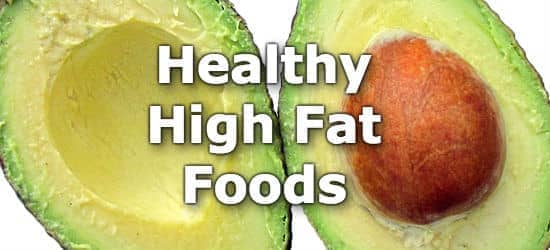 Next ➞
Next ➞
